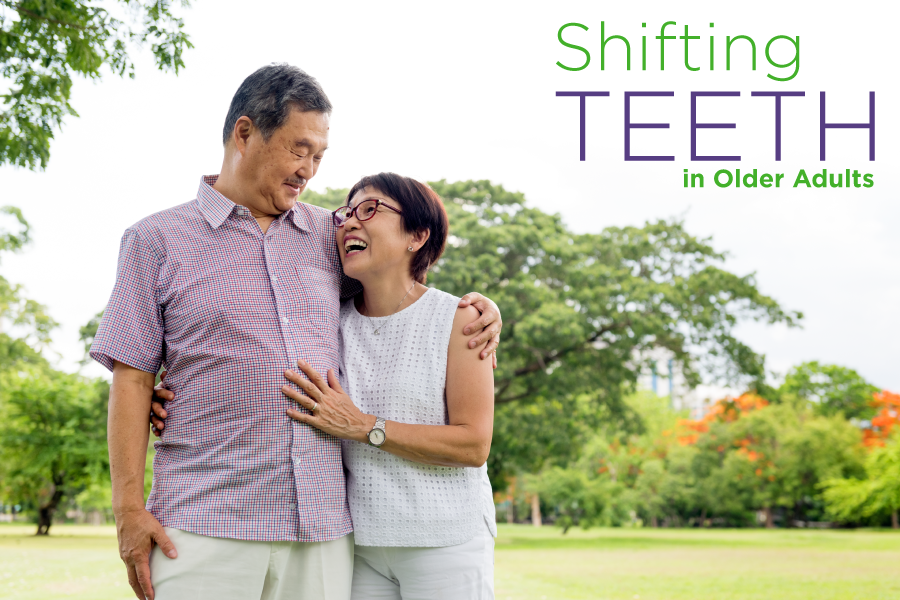Crowded or Crooked Teeth in Older Adults
By Shelby Tatomir on May 10, 2019 in Dental Health

Our teeth determine how our mouth functions. Take chewing, for example. Thousands of years ago, humans ate much tougher foods than we do today. They certainly weren’t using knives and forks to cut up their steaks. Since we’ve shifted to softer foods, our jaws aren’t exercising like they once did. As a result, we’ve evolved and now have smaller jaws. But, our teeth still take up the same amount of space. This contributes to why we get crooked or crowded teeth.
When our molars come in, they can push their way into a too-small space. They can cause our teeth to shift. That’s why many opt for wisdom teeth removal. Malocclusion is an umbrella term for when our teeth and jaw grow and develop in variations of their correct position. It’s one of the most common oral health conditions. Crowded teeth have been proven to negatively impact your quality of life and self-esteem!
Crooked teeth don’t have an age limit. Have you ever wondered how our teeth or bite shift? Or why flossing is more difficult as we grow older? Crowded teeth are a common side effect of aging for a variety of reasons. The oral health of older adults is impacted by:
- Genetics
- Oral health habits
- Lifestyle habits
- Dental disease
- Overall health
- Nutrition
How Do Crowded or Crooked Teeth Impact our Lives?
The top teeth and bottom teeth are designed to bite together evenly. When our bite is misaligned, it can impact chewing, speaking, and smiling. Did you know that it can also lead to feelings of tiredness and pain?
One study found that:
- 62 percent of adults with bite problems surveyed reported facial pain,
- 41 percent reported headaches or migraines,
- and another 41 percent reported teeth sensitivity.
If you’ve noticed teeth crowding as you age, but don’t have pain, that’s great news! But, that doesn’t mean they aren’t causing issues. Flossing is more difficult and less effective with crooked teeth. As we try to slide it between our teeth, crowding and uneven pressure can trap plaque and hide bacteria.
Are you asking yourself, “what can I do about misaligned or crooked teeth?”
Braces in adulthood are nothing to fear. Because our oral health significantly impacts our overall wellness, getting braces isn’t merely a cosmetic fix. It can also reduce tooth decay, gum disease, and a slew of other oral and overall health concerns. Adults like you are choosing to straighten their teeth later in life more and more. The American Association of Orthodontists noted that one in five orthodontic patients are over age 18 these days! One orthodontist reported that half of his patients today are adults.
Braces place pressure on the teeth to adjust them so that your bite aligns. Appointments every few months allow your orthodontist to make adjustments and keep the alignment process going. Your dentist appointments are still vital, even if you’re seeing the orthodontist. Your teeth still need twice a year cleanings (possibly more-so) when you have braces.
Because older adults are keeping their teeth longer, it’s important we know how to keep them healthy! Braces and preventive care can help an adult with teeth crowding maintain their oral health.
The most common types of braces:
Standard metal braces: brackets are glued to the teeth and connected with a wire. The wire is tightened every one to two months, slowly moving the jaw and teeth into place. These are around $5,000 to $9,000.
- Ceramic braces: Ceramic braces are similar to metal braces, but their brackets are clear or tooth-colored. They are slightly more expensive.
- Clear aligners: Clear trays are designed to fit seamlessly over your teeth. They can help with minor shifting of the teeth. These run between $3,000 and $5,000.
- Lingual braces: These lesser-known braces fit on the inside of your teeth rather than the outside.
Unfortunately, many older adults don’t think braces are right for them because of their age. When surveyed, participants in their 50s, 60s, and 70s were 30 percent less likely to be interested in orthodontia than those in their 20’s.
Remember, straight teeth aren’t just for the young! And having a healthy smile can keep you young. Individuals surveyed over 40 years old thought “they were ‘too old’ for orthodontic treatment” - we’re here to help change that misconception!
Take the time to discuss with your dentist if straightening your teeth would benefit your smile and your wellness. Your orthodontic coverage and options may vary based on your plan type.
Understanding your coverage is the best way to take advantage of its features. Review your plan details to understand what your coverage looks like in regards to your treatment. Questions? Contact us.